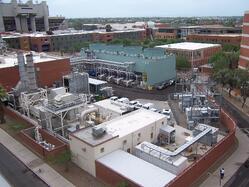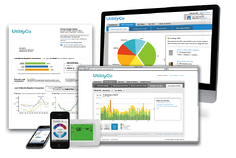The U.S. Environmental Protection Agency’s (EPA’s) plan to regulate carbon emissions is just the latest challenge facing the U.S. electric power system. Technological innovation is disrupting old ways of doing business and accelerating grid modernization. Earlier this year, AEE released Advanced Energy Technologies for Greenhouse Gas Reduction, a report detailing the use, application, and benefits of 40 specific advanced energy technologies and services. This post is one in a seriesdrawn from the technology profiles within that report.
 Combined Heat and Power (CHP), also called cogeneration, generates both electricity and useful heat from the same fuel source. CHP typically involves dedicated equipment to generate electricity, followed by recovery of exhaust/waste heat for use in industrial processes, space heating, or water heating. Any fuel can be used for CHP, including fossil fuels and renewable fuels. In certain industries, onsite “waste” fuels are used for CHP, such as wood chips, bark and sawdust in forest products, blast furnace gases in steel mills, and various process gas streams in refining and petrochemicals. Because thermal energy (steam, hot water) is more difficult to transport than electricity, CHP systems are typically installed at or near a suitable thermal load. Most U.S. CHP capacity is installed at industrial sites, but it is also fairly common at college campuses, hospitals, military bases, and in district energy plants.[1] Housing complexes and commercial buildings also use CHP. So-called micro-CHP can be used in residences and small commercial buildings for water or space heating or for heating swimming pools. CCHP (combined cooling, heating, and power) is a variation of CHP that uses the waste heat to drive a cooling system (via an absorption chiller) in addition to generating heat and power. CCHP can make sense when heating loads are more seasonal and where there are large cooling requirements, resulting in higher overall utilization of waste heat than would be possible just with CHP.
Combined Heat and Power (CHP), also called cogeneration, generates both electricity and useful heat from the same fuel source. CHP typically involves dedicated equipment to generate electricity, followed by recovery of exhaust/waste heat for use in industrial processes, space heating, or water heating. Any fuel can be used for CHP, including fossil fuels and renewable fuels. In certain industries, onsite “waste” fuels are used for CHP, such as wood chips, bark and sawdust in forest products, blast furnace gases in steel mills, and various process gas streams in refining and petrochemicals. Because thermal energy (steam, hot water) is more difficult to transport than electricity, CHP systems are typically installed at or near a suitable thermal load. Most U.S. CHP capacity is installed at industrial sites, but it is also fairly common at college campuses, hospitals, military bases, and in district energy plants.[1] Housing complexes and commercial buildings also use CHP. So-called micro-CHP can be used in residences and small commercial buildings for water or space heating or for heating swimming pools. CCHP (combined cooling, heating, and power) is a variation of CHP that uses the waste heat to drive a cooling system (via an absorption chiller) in addition to generating heat and power. CCHP can make sense when heating loads are more seasonal and where there are large cooling requirements, resulting in higher overall utilization of waste heat than would be possible just with CHP.
 The U.S. Environmental Protection Agency’s (EPA’s) plan to regulate carbon emissions is just the latest challenge facing the U.S. electric power system. Technological innovation is disrupting old ways of doing business and accelerating grid modernization. Earlier this year, AEE released
The U.S. Environmental Protection Agency’s (EPA’s) plan to regulate carbon emissions is just the latest challenge facing the U.S. electric power system. Technological innovation is disrupting old ways of doing business and accelerating grid modernization. Earlier this year, AEE released  A building envelope consists of all the elements of a building that separate its interior from the exterior environment. This includes external walls, insulation, windows and roofing. Technological advancements in envelope materials have lowered building operating costs. Examples include high-performance insulation, reflective surfaces, air sealing, and efficient windows.
A building envelope consists of all the elements of a building that separate its interior from the exterior environment. This includes external walls, insulation, windows and roofing. Technological advancements in envelope materials have lowered building operating costs. Examples include high-performance insulation, reflective surfaces, air sealing, and efficient windows.  A Building Energy Management System (BEMS) is an integrated system of software, hardware and services that controls energy use through information and communication technology. Used primarily in commercial buildings, BEMS technology works by monitoring, automating, and controlling building systems such as heating, ventilation, air conditioning, thermostats, and lighting to increase building energy efficiency and improve comfort. Adoption of cloud technology has expanded BEMS from traditional energy visualization and energy analytics to include demand response and property management.
A Building Energy Management System (BEMS) is an integrated system of software, hardware and services that controls energy use through information and communication technology. Used primarily in commercial buildings, BEMS technology works by monitoring, automating, and controlling building systems such as heating, ventilation, air conditioning, thermostats, and lighting to increase building energy efficiency and improve comfort. Adoption of cloud technology has expanded BEMS from traditional energy visualization and energy analytics to include demand response and property management. Behavioral energy efficiency (BEE) employs messaging grounded in behavioral science to produce simple, actionable messages that are relevant to customers and motivate them to save energy. Extensive research
Behavioral energy efficiency (BEE) employs messaging grounded in behavioral science to produce simple, actionable messages that are relevant to customers and motivate them to save energy. Extensive research